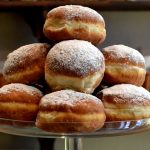
Paczki
Paczki (it should be noted that WordPress has not the "a" with the little hook on the bottom which is the proper vowel for this word) are the traditional Fat Thursday (Yes!) and Fat Tuesday treat before Lent begins. In Chicago and Hamtramck and NYC, lines may form outside of Polish bakeries for these gems. You can avoid these line, or build one of your own, by making your own pre-Lenten treats.
Ingredients
- 12 oz Warm milk
- 10 g Instant yeast
- 4 oz Granulated sugar
- 70 g Unsalted butter, room temperature
- 1 each Large egg
- 3 each Egg yolks
- 15 ml Rum Use the kid's medicine cup
- 1 t Salt
- 814 g All-purpose flour
- 72 g All-purpose flour
Equipment and oil
- 1 Gallon Frying oil I prefer Peanut
- Cinnamon Sugar
- Powdered Sugar
- 1 jar Rose Petal Jam Or rose hip marmalade
- Sheet pan and draining rack
Instructions
Mix the Paczki
-
Scale the flour, less ½ C, yeast, and salt into a bowl.
-
Paddle the butter and sugar to a pale white color.
-
On low speed, add the eggs, one at a time, then the rum.
-
Add the flour and cool milk in alternating additions starting and ending with the flour. Turn speed to medium and mix for 3 minutes or until the dough starts to clean the sides of the bowl. It should soft, but not very sticky. If it is too sticky, add the remaining flour and mix on medium 1 more minute.
-
Place the dough into a buttered stainless steel bowl, cover with plastic wrap and allow to proof 1 to 1.5 hours, or until nearly doubled.
-
Turn the dough out onto a floured counter or work table and roll ½ inch thickness. Too thin and they will not be tall enough to hold filling. Too thick and they will not cook in the center.
-
Cut the Puczki with a 3” round cutter pushing straight down and twisting only when the cutter reaches the table.
-
Place the paczki onto a lightly floured pan, drape a clean kitchen towel over them and allow to proof till 1” high.
-
While the paczki are proofing, prepare the oil and pan for frying. In a deep and wide 6 qt or more pot, or a Le Crueset casserole, bring 3 to 4 inches of oil slowly to 350 degrees F. Use a digital candy or fryer thermometer to keep the temperature even. (If you are using a deep fryer, new, clean oil is best so the paczki don’t pick up the flavors from the previous cooks. Set the device to 350 and wait).
-
When the paczki are 1” tall, carefully remove them from the sheetpan, place them into the oil—don’t drop them; they’ll splash hot oil—and fry until the bottom is well golden brown. Flip the paczki over, fry again till well golden brown then remove each as it is done to a draining rack on a sheet pan. Fry 3 or 4 at a time watching the temperature of the oil so it remains nearly 350 degrees. Too many paczki will make the temperature reduce and the paczki will taste greasy and dense. Better to fry fewer than more. If you do not have a draining rack, several paper grocery bags or a thick pad made of paper towels will suffice.
-
When cooled, poke a hold into the side of the paczki with a table knife and work the blade a wee bit up and down and to and fro to make a hole for the filliing.
-
Place the filling into a small pastry bag or zip top bag and cut the point off the bag. Push the bag into the hole made with the knife and gently squeeze jam into the center until it starts to return out the hole.
-
Dust or glaze the paczki while they are cool. If you are using an apple filling, a cinnamon sugar is nice, but place the paczki into the cinnamon sugar while the are quite warm. Let them cool, them create the hole and fill.
-
Find the nearest Polish person you can find and share in the custom that is Paczki Day. All of Hamtramck will be joining you.
Recipe Notes
In most cases, most any tool will do for most any job. In frying, however, I find that a few things are really important to prevent burning your fingers, burning your food, and keeping the area safe.
A spider is a tool designed for fryers. A high quality digital candy/fryer thermometer as well as draining racks and pans to help the fried things drip their excess oil also help with a great finished product.
If you want to splurge, a table top deep fryer is a great toy, but they do make one heck of a mess and can make a house plenty stinky. I keep mine outside under the eve. The kitchen is clean (well, not greasy) and doesn't smell of fryer.